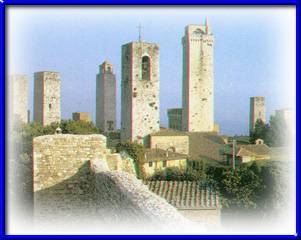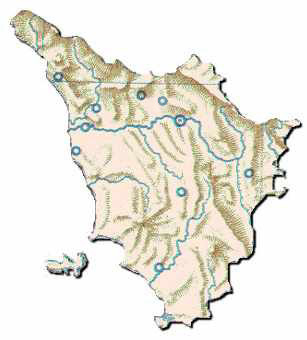 |
TOSCANA
|

Back to Italy |
Provinces
- This region has 10 provinces: Arezzo, Firenze, Grosseto, Livorno, Lucca,
Massa Carrara, Pisa, Pistoia, Prato, Siena
Chief town
- Firenze
Surface
- kmq 22993
National Parks
- National Park of Arcipelago Toscano (1989) National Park of Monte Falterona,
Campigna and of Foreste Casentinesi (1990)

Russian Version |
 |
|
Origin of the name:
The inclusive zone between Arno and Tevere was the
territory of Etruschis or Tuschi in the epoch before the Romans . The
name of the Region in that times was Etruria or Tuscia. Subsequently from
Tuscia was formed the name in Tuscany.
Reliefs - Passes - Coasts -
Islands:
Only with some top, Appennino Tosco-Emiliano overcomes
the 2000 meters (Mountain Cimone, Mountain Cusna). In the part more to north of
Arno, Appennino contains a mountainous zone formed by more tall mountains: Alps
Apuane and the chain of Pratomagno. Between Appennino and the coast we find
Antiappennino with isolated mountains and more low; we remember the Hills of
Chianti, Hills Metallifere, Argentario and Massiccio of Amiata Mountain, where
an ancient out volcano is found. The passes are important because they favor
the communications between Lowland Padana, Central Italy and the slope
tirrenico. The most important is: the Footstep of Cisa, that connects Massa
Carrara to Spezia, the Footstep of Abetone between Pistoia and Modena, the
Footstep of Futa and Raticosa that connect Florence to Bologna and the Footstep
of Mandrioli that connects Oriental Tuscany to Romagna. The coasts are low,
uniforms and sandy in the northern zone and from the Promontory of Piombino to
Lazio; while between Livorno and Promontory of Piombino are tall and rocky. To
the breadth of the Tuscan coasts there are some islands that compose Tuscan
archipelago. The most important is: Gorgona, Capraia, Island in Elba, Pianosa,
Montecristo, island of Lily and the island of Giannuti. Not the very wide
lowlands are fertile, and intensely populated. The principal is: Valdarno
Superiore, Valdarno Inferiore, Versilia, Alps Apuane and Maremma.
| Landscape: |
| The landscape in Tuscany is in a large extent hilly and
mountainous; the few level areas have limited to the coastal zones and the fund
of the valleys. Manifold are the aspects that offer a harmonious landscape
composed from mountains, hills and lowlands. The dense mountains of vegetation
have covered of oaks, chestnut trees, beech trees and firs. In the hilly tops
we find the ulivis, the cypresses or big cultivated expanses to vineyards,
where are built in way isolated houses farmer's or small suburbs. The cities
rich in history are placed in the level areas of the fund valley and they still
maintain preserved numerous monuments and artistic treasures. Zones of wild
beach are still alternated with modern bathing zones. The ground and the
climate favor agriculture. The subsoil is enough rich of mineral.
|

Sees of Florence
|
Agriculture - Stock-farm -
Fishing:
The agriculture ago half century was the source of
primary wealth. Today we realize that industrial activities have overpowered
the agricultural job; it is not difficult to find uncultivated countries and
abandoned houses. The grapevine and the ulivo are the principal crops. From the
first one the famous wines of the zone of Chianti are drawn. Other crops of
small importance are cereals, fruit and vegetables. In constant development we
find the crops of sugar beets and tobacco. The breeding concerns the cattle and
the swines, where the production of meat is considerable. The fishing is not
very developed. Viareggio and Cecina are the greatest fishing harbors, even if
in the last years Livorno has assumed a certain importance with the port of
fishing-boats of fishing of tall sea.
| Industry - Tourism: |

The Towers of S. Giminiano
|
The big industries are not very develop.
Those present are all formed by the small and averages firms. The more
developed it is that mining and iron in the zones of Piombino and Livorno.
Another characteristic production is that of the electric energy drawn by the
blowpipes boraciferi of the zone of Larderello. Other sectors of detach are,
that mechanic (steel pipes, pads to spheres, railway cars, textile cars and
motorcycles), that chemical (sour solforico and boric, dyes, fertilizers and
pharmaceutical), that of the glass, that calzaturiero and that of clothes, that
textile and that of the tanning of the skin even if it pollutes the courses of
water a lot. Of relief are the caves of marble and alabaster. The tourism is
the principal industry in Tuscany, thanks to the zones of Italian interest not
only, but above all international.
|
The destinations more aspired are three: the first one
for the famous cities of historical-cultural interest as Florence, Siena, Pisa,
Arezzo; the second that of the bathing zones with Viareggio, Marina of Mass,
Beaches of Camaiore, Forte of Marbles and the island in Elba; third are that of
the thermal zones with Montecatini, Chianciano and Baths of Lucca.
Position and Frontier:
To west we find the coastal tirrenico, while from the
oriental part Appennino Tosco-Emiliano divides the Region from Emilia Romagna
and from Liguria. From the border with Umbria and Marche follows a sinuous line
along the mountains that are issued in Appennino. To south a hilly zone divides
it from Lazio. The before islands the coast, belongs to the Region. To north
Tuscany confines with Emilia Romagna and a brief line of Marche, to east with
Marche and Umbria, to south with Lazio, to west with Ligure Sea and Tyrrhenian
and a brief line of Liguria.
Rivers - Lakes:
The irregular reliefs make the course of the rivers,
that go down, long and tortuous. Arno that is born from Falterona Mountain is
the most important. For length it is the eighth Italian river and its basin
occupies a third of the Region. Arno receives numerous tributaries: Sieve and
the right Bisenzio, Chiana, Pesa, Elsa and Era. The torrential
characteristics of these rivers, let at times overflow Arno provoking floods.
We remember that disastrous of 1966 that flooded Florence. Other
important rivers are Serchia, Cecina, Ombrione and Magra that flow in
Tyrrhenian. Tevere and Fiora cross for a brief line Tuscan territory entering
in Lazio then.
Il clima è generalmente mite, soprattutto nella fascia
costiera. Il litorale è spesso battuto dallo Scirocco, un vento caldo umido
proveniente dall’Africa, che provoca frequenti precipitazioni. Le catene
appenniniche riparano la Regione dai venti freddi che soffiano da nord est.
Climate:
The climate is mild generally, especially in the
coastal band. The shore has often beaten from Scirocco, a deriving damp warm
wind from Africa, that provokes frequent precipitations. The chains of
Appennini mend the Region from the twenty colds that blow from north east.
Population:
The population has assembled in the inclusive zone
mostly between Florence, Livorno, Pisa, Lucca and Pistoia, where we find a
third of the regional general population. Densely other inhabited zones are
those of Arezzo, Massa and Siena. The rest of the Tuscan territory has
populated poorly. In Tuscany more than in other regions, we notice the
abandonment of the mountains and the hills, because many farmers prefer the job
in the city rather than to work earth. In Tuscany we find numerous immigrated
among which also many agriculturists of the Midday, that take possession of
abandoned powers.
Communication:
A sharp pain net either railway that road and motorway,
colleague Tuscany in all its places to the rest of Italy. The greatest railway
lines are those of Turin-Genoa-Pisa-Rome and Milan-Bologna-Florence-Rome. In
the oriental part of the region passes the highway of the Sun, while Siena and
Florence have been connecting from a speedway. The Tuscan principal airport is
situated in Pisa and precisely in the place of St. Giustot.
Web Site designed by
MediaSoft - © Copyright 1998-1999 - All rights reserved






